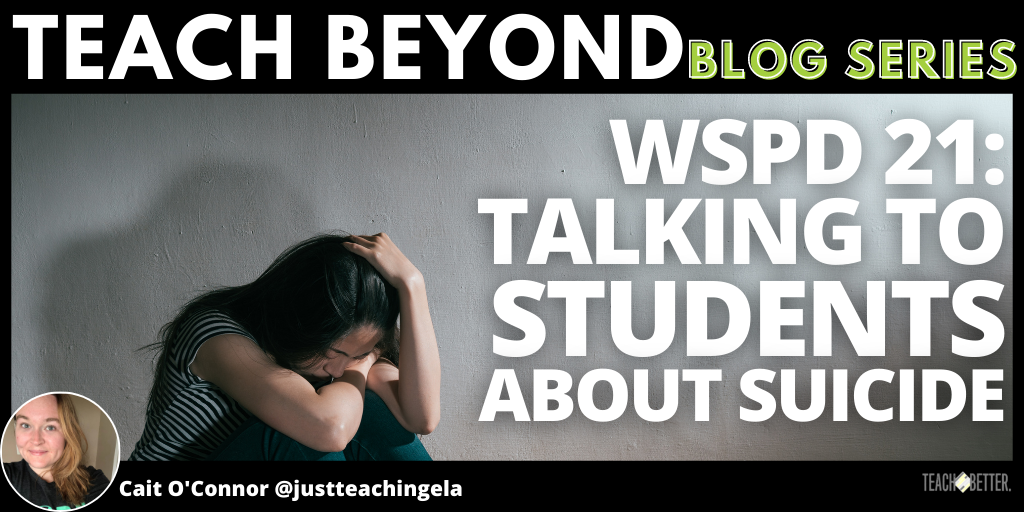TL;DR:
- It’s important to talk about suicide. It’s everyone’s role to discuss, prevent, and destigmatize suicide.
- Suicide prevention is social justice and access issue as well as a mental health issue.
- We need to become a trauma-informed, caring educator so we can support students who need help.
- Below you will find a list of common myths about suicide talk.
Generally, I don’t talk about this subject. But this issue is one that’s important to me. Given the focus on mental health in a pandemic, it’s more important than ever that we talk about how to talk about suicide.
September 10th is World Suicide Prevention Day
Every year on September 10th, organizations and individuals acknowledge World Suicide Prevention Day. Suicide prevention is about more than sharing a hotline and referrals and resources. Suicide prevention and alertness is everyone’s job, year-round; especially at school.
Talking About Suicide: It’s Not Only Up to Counselors
Teachers, nurses, school-related professionals, and paraprofessionals all have a role in discussing, preventing, and de-stigmatizing suicide at school. The topic of suicide and mental illness may seem like one that is bound only to come up in health class, but it’s a subject that truly transcends content area boundaries. Suicide prevention is everyone’s job.
Suicide prevention is also more than just a mental health issue. It is a social justice and an access issue. Sharing hotline numbers is a step that folks often default to, thinking they’ve ‘done their part’ to prevent suicide. Suicide prevention is also about more than self-care, mental health days, and “treat yourself” culture. Income equality is suicide prevention. Housing access is suicide prevention. Healthcare is suicide prevention. Anti-racism is suicide prevention. Resisting ableism is suicide prevention. Food security is suicide prevention. Literacy is suicide prevention. Proper pronouns and facility access for trans and nonbinary students are suicide prevention. It takes an entire community to provide these things to our students and their families.
Given the focus on mental health in a pandemic, it's more important than ever that we talk about how to talk about suicide. Click To TweetTalking About Suicide: Build a Care Network
Studies have found that ‘warning signs’ are less common than we think. This means that for our students, we have to ‘reach in’ and invest in their social and emotional health, instead of expecting them to ‘reach out’ to us. Becoming a trauma-informed, suicide-alert educator is necessary work.
However, teachers are not mental health professionals. It can be overwhelming to feel like we need to take on the role of social worker or counselor, but we can’t control what information we are aware of and what students tell us. It’s important that we don’t just pass the buck, especially if they trust us enough to tell us how they are feeling or that they’re worried about a classmate or friend. But we don’t have to handle the situation alone, and we can emphasize to students that we are going to help them build a team or a network to keep them and/or their classmates safe.
As an educator, you are a mandated reporter, and this means that the information that a student tells you cannot stay with you alone. Students should know that you’re interested in keeping them safe; you want to help them find help that they can trust. Thank them for trusting you with their thoughts and move into action.
Talking About Suicide: Common Myths about ‘Suicide Talk’
People often think that discussing suicide or even saying the word can prompt someone who is considering it to act.
In reality, being upfront about suicide stresses the finality of taking one’s own life, and can actually prompt conversations that keep people safe in the long run. There are a number of ways to talk to people about suicide without glorifying the act or triggering them, and these nuances are important.
If you’re going to ask someone if they are considering suicide, don’t use euphemisms; be direct.
Avoid terms like “hurt yourself,” which downplay the issue. Harm and hurt are words for when a person is engaging in self-injury. These actions or feelings may not be related to feelings of suicidality and can muddle the resources or help they receive.
The person matters more than the means.
If you think someone is going to act on suicidal thoughts, asking them about the means by which they have a plan is a way of risk assessing. It can tell you a lot about what tools they have access to, what their timeframe might be, and how to proceed with getting them help to stay safe.
When discussing a completed suicide, however, the means by which a person acts are not the important part.
It’s important to avoid discussing the means of a suicide loss. It’s especially important to avoid with those who are easily triggered or who are navigating their own adolescence and vulnerable emotions. The means by which a suicide occurs separates the person from their actions, and it’s important to focus on the person who is at risk of suicide more than anything else.
Avoid the term “commit/ted suicide.”
This emphasizes the action rather than the person and minimizes the factors that led them to be in pain in the first place. “Took one’s own life” or “died by suicide” are more appropriate, because they take away the connotation that a person had control over the mental health crisis conditions that led them to feel like suicide was their only option.
[scroll down to keep reading]

What can your school do to address and prevent suicide?
- Host a SAFETalk Training for students and teachers.
- Take a Mental Health First Aid training.
- Become ASIST certified.
- Invite peers and survivors to speak at your school.
- Attend and fundraise for a local suicide prevention walk.
Resources
https://studenthealth.usc.edu/counseling/guide-talking-about-suicide/
https://www.health.harvard.edu/blog/suicide-often-not-preceded-by-warnings-201209245331
https://www.durhamcollege.ca/wp-content/uploads/safeTALK-Information-Sheet.pdf
https://www.iasp.info/wspd2021/
https://afsp.org/suicide-prevention-research-federal-priority
About Cait O’Connor
Cait O’Connor is a fourth-year public school English/ESOL educator in New York, committed to social justice and equity in education and beyond.



